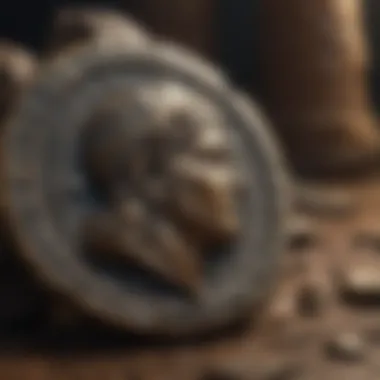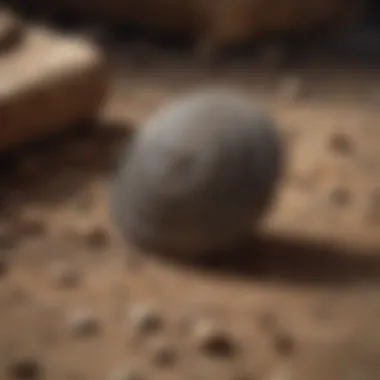Unveiling the Riches: Metal Detector Discoveries Revealed


Rock and Fossil Identification
When delving into the realm of metal detecting, identifying rocks and fossils intertwines with the treasures unearthed. Understanding various types of rocks and fossils is imperative for enthusiasts. Rocks may range from sedimentary to igneous or metamorphic, showcasing distinct characteristics essential for differentiation. Fossils, on the other hand, can vary from imprints to petrified remains, each holding valuable insights into past organisms. Employing tools such as magnifying glasses, geology hammers, and streak plates aids in accurate identification, amplifying the excitement of discovering these geological wonders.
Introduction
The introduction sets the stage for delving into the captivating world of discoveries made with metal detectors. It serves as the gateway to a realm where ancient artifacts, valuable relics, and hidden treasures await discovery. By shedding light on the enthralling finds that enthusiasts have unearthed, the introduction piques the curiosity of readers, inviting them to embark on a journey through history's gems. Exploring the significance of metal detector finds not only offers a glimpse into bygone eras but also showcases the meticulous work of collectors and history buffs passionate about uncovering treasures buried beneath the earth's surface.
Metal detecting has evolved into a pursuit that combines elements of adventure, historical investigation, and preservation. Enthusiasts equipped with metal detectors roam landscapes in search of precious finds that range from coins and jewelry to weapons and armor, each with its own tale to tell. The allure of uncovering artifacts that have withstood the test of time fuels the passion of individuals drawn to this fascinating hobby. As we embark on this exploration of metal detector finds, we are poised to witness the merging of technology, archaeology, and history, offering a multifaceted perspective on the importance of preserving and understanding our shared past.
The introduction of this article encapsulates the allure and essence of metal detecting, presenting it as a window into a world brimming with untold stories and hidden treasures. By delving into the realm of metal detector finds, we not only unearth artifacts but also unravel the mysteries of civilizations long past, fostering a deeper appreciation for the heritage that lies beneath our feet. This section serves as the foundation upon which the subsequent discussion of techniques, discoveries, and ethical considerations is built, offering readers a comprehensive insight into the riveting world of unearthing treasures with metal detectors.
Metal Detector Findings: An Overview
In this article, we delve into the intriguing realm of discoveries made with metal detectors, shedding light on the captivating finds that enthusiasts have unearthed. The significance of metal detector findings lies in their ability to unveil historical artifacts that offer a glimpse into the past. These discoveries serve as tangible connections to bygone eras, sparking the interest of collectors and history enthusiasts worldwide. Understanding the various elements and considerations surrounding metal detector findings is essential for appreciating their value and cultural significance.
Historical Significance
The Impact of Metal Detector Finds on Archaeology
The impact of metal detector finds on archaeology cannot be overstated. These discoveries have revolutionized the field by providing archaeologists with valuable insights into ancient civilizations and historical events. By uncovering artifacts that may have otherwise remained buried, metal detector finds contribute significantly to expanding our knowledge of the past. The ability to pinpoint specific locations for excavation based on these findings has transformed archaeological practices, making the process more efficient and targeted.
Ancient Discoveries That Shaped Our Understanding
Ancient discoveries unearthed through metal detectors have played a pivotal role in shaping our understanding of history. These artifacts offer a firsthand look into the lives and customs of ancient societies, opening windows to lost cultures and traditions. By studying these discoveries, researchers can piece together the puzzle of the past, filling gaps in historical narratives and challenging existing theories. The unique perspective provided by ancient metal detector finds enriches our comprehension of civilizations long gone, adding depth to academic discourse and public fascination.
Types of Discoveries


Coins and Currency
The discovery of coins and currency holds significant value in unveiling economic systems and trade networks of ancient societies. These finds provide tangible evidence of monetary exchange, offering glimpses into commerce, governance, and social hierarchies. Coins and currency serve as time capsules, preserving cultural and political dynamics of their respective eras. Studying these artifacts not only sheds light on economic practices but also reveals the artistic and technological advancements of past civilizations.
Jewelry and Adornments
Jewelry and adornments found through metal detection offer insights into personal adornment and social customs of ancient peoples. These artifacts reflect individual taste, status symbols, and craftsmanship of bygone eras. By analyzing the materials and designs of these pieces, researchers can unravel societal norms, religious beliefs, and aesthetic preferences of ancient cultures. Jewelry and adornments serve as wearable artifacts that transcend time, connecting present-day audiences to the ornamentation practices of their ancestors.
Weapons and Armor
The discovery of weapons and armor provides a glimpse into the military technologies and combat strategies employed throughout history. These artifacts reveal insights into warfare, defensive tactics, and societal structures of ancient civilizations. By studying the construction and usage of weapons and armor, researchers can decipher the martial practices and power dynamics of past societies. Weapons and armor serve as tangible links to historic battles and conquests, highlighting the evolution of weaponry and the human inclination towards conflict.
Tools and Utensils
Unearthing tools and utensils through metal detection offers a practical view of daily life and craftsmanship in ancient civilizations. These artifacts showcase the functional capabilities and innovation of past societies in toolmaking and domestic activities. By examining the design and materials of tools and utensils, researchers can infer about cooking methods, agricultural practices, and technological advancements of earlier eras. Tools and utensils act as utilitarian relics that reveal the resourcefulness and ingenuity of our ancestors.
Notable Finds
The Staffordshire Hoard
The Staffordshire Hoard stands as a testament to the richness of Anglo-Saxon artistry and craftsmanship. This remarkable discovery, comprised of intricate gold and garnet artifacts, showcases the skill and creativity of the early medieval period. The hoard's significance lies in its sheer aesthetic beauty and historical value, providing unparalleled insights into the artistic traditions of the time. Studying the Staffordshire Hoard offers a glimpse into the elite society and cultural splendor of the Anglo-Saxon era.
The Hoxne Hoard
The Hoxne Hoard represents one of the largest and most diverse Roman treasure troves ever discovered in Britain. This collection of gold and silver objects, including jewelry, tableware, and coins, offers a comprehensive view of Roman wealth and luxury. The hoard's archaeological importance extends beyond its material value, shedding light on Roman occupation and influence in ancient Britain. Exploring the Hoxne Hoard unveils the opulence and sophistication of Roman society, providing glimpses into daily life and cultural exchanges of the era.
The Crosby Garrett Helmet


The Crosby Garrett Helmet stands out as a rare and exceptional Roman cavalry helmet, renowned for its exquisite craftsmanship and artistic detailing. This remarkable find exemplifies the technical skill and decorative flair of Roman metalwork, showcasing intricate designs and symbolic motifs. The helmet's discovery has captivated scholars and art enthusiasts alike, offering a window into the military customs and aesthetic preferences of Roman soldiers. Examining the Crosby Garrett Helmet reveals the intersection of functionality and artistry in ancient Roman armor, highlighting the craftsmanship and cultural values of the period.
Techniques and Methodology
In the realm of discoveries with metal detectors, understanding the techniques and methodology is paramount to success. Techniques and methodology encompass a variety of crucial aspects that contribute to the effectiveness of metal detecting, making it a vital focus of this article. From practical operations to strategic approaches, this section delves into the nuts and bolts of how enthusiasts uncover hidden treasures.
Metal Detector Operation
Understanding Detector Signals
When it comes to metal detecting, the ability to interpret detector signals accurately is fundamental. Understanding detector signals plays a pivotal role in distinguishing between valuable finds and regular artifacts. Delving deep into the nuances of these signals allows enthusiasts to hone their skills and maximize their chances of unearthing significant discoveries. The key characteristic of understanding detector signals lies in the meticulous attention to variations and patterns that can signal the presence of specific metals beneath the surface. This critical skill is a popular choice for enthusiasts as it represents the gateway to uncovering hidden treasures with precision. The unique feature of understanding detector signals is its ability to provide real-time feedback, enabling detectorists to adjust their search techniques instantaneously based on the signals they encounter in the field. While advantageous in its precision, understanding detector signals also comes with the challenge of being subject to environmental interferences, requiring an experienced detectorist to navigate these complexities effectively.
Adjusting Settings for Optimal Results
Another essential aspect of metal detector operation is the art of adjusting settings for optimal results. The ability to fine-tune detector settings according to the specific terrain and targets at hand is a game-changer in the world of metal detecting. By customizing settings such as sensitivity, discrimination, and ground balancing, detectorists can enhance their chances of detecting valuable items while minimizing interference from unwanted materials. The key characteristic of adjusting settings for optimal results lies in its adaptability to diverse detecting environments, allowing enthusiasts to optimize their machines for peak performance. This feature is a popular choice for enthusiasts seeking to maximize their efficiency and success rates during metal detecting expeditions. The unique feature of this technique is its versatility, enabling detectorists to tailor their settings on the go to suit varying soil conditions and target types. While advantageous in its flexibility, adjusting settings for optimal results can be a nuanced practice that requires a balance between sensitivity and stability to achieve the best outcomes.
Search Strategies
In the pursuit of uncovering treasures with metal detectors, strategic search approaches are key to success. Search strategies encompass a range of methodologies that guide detectorists in covering vast areas efficiently and effectively, increasing the likelihood of making significant finds.
Grid Patterns and Sweep Techniques
Grid patterns and sweep techniques constitute a fundamental aspect of search strategies when using metal detectors. Implementing systematic grid patterns ensures comprehensive coverage of a designated area, minimizing the chances of overlooking potential targets. The key characteristic of grid patterns lies in their ability to organize search efforts in a methodical manner, maximizing efficiency and reducing the risk of missing valuable discoveries. This structured approach is a popular choice among detectorists as it provides a systematic framework for thorough exploration. The unique feature of grid patterns is their scalability, allowing detectorists to adjust the grid size based on the terrain and target density to facilitate efficient searches. Despite its advantages in ensuring thorough coverage, grid patterns require patience and discipline to execute effectively, as meticulous attention to detail is essential for success.
Identifying Hotspots for Finds
When it comes to successful metal detecting, the ability to identify hotspots for finds can significantly enhance the chances of making valuable discoveries. Hotspots are areas that exhibit higher probabilities of containing artifacts or treasures based on historical data, geological features, or anecdotal evidence. By honing the skill of pinpointing these hotspots, detectorists can strategically focus their efforts on areas with the highest likelihood of yielding precious finds. The key characteristic of identifying hotspots lies in the strategic analysis of landscape features, historical records, and previous finds to determine high-potential locations for exploration. This strategic approach is a popular choice for detectorists looking to maximize their time and resources by concentrating on areas with promising potential. The unique feature of identifying hotspots is its predictive nature, allowing detectorists to make informed decisions about where to search based on informed assessments rather than random selection. While advantageous in its targeted approach, identifying hotspots requires thorough research and a comprehensive understanding of the factors that influence the likelihood of finding treasures in specific locations.


Preservation and Ethical Considerations
In this extensive exploration of metal detector finds, Preservation and Ethical Considerations stand as crucial pillars ensuring the integrity and value of the discoveries unearthed. Preservation plays a vital role in safeguarding the artifacts for future generations, maintaining their historical significance and archaeological value. Ethical considerations are essential to ensure that the treasures found are treated with respect and in alignment with legal frameworks.
Conservation Practices
Cleaning and Storing Finds
Cleaning and storing finds is a meticulous process that requires delicacy and precision. Properly cleaning artifacts helps to preserve them by removing dirt and debris without causing damage. Storing the finds in suitable containers or environments protects them from external elements that could deteriorate their condition. The meticulous care taken in cleaning and storing finds ensures their longevity and allows for further study and appreciation.
Consulting with Archaeological Authorities
Consulting with archaeological authorities is a crucial step in the preservation and understanding of metal detector finds. By engaging with experts in the field, detectorists can gain insights into the historical context of their discoveries and contribute valuable information to the archaeological community. Collaboration with authorities ensures that finds are documented accurately, allowing for proper attribution and interpretation within the broader historical narrative.
Legal and Ethical Guidelines
Cultural Heritage Laws
Cultural heritage laws serve as a protective framework for preserving artifacts of historical significance. These laws help to regulate the excavation, ownership, and trade of cultural artifacts, ensuring that the heritage of a nation is safeguarded and not exploited for personal gain. Adhering to cultural heritage laws promotes responsible collecting practices and contributes to the broader conservation efforts of our shared history.
Respecting Archaeological Sites
Respecting archaeological sites is fundamental to the preservation of our collective past. By treating these sites with care and reverence, we can ensure that valuable information is not lost or damaged through irresponsible actions. Respecting archaeological sites involves following designated protocols, such as obtaining permits for metal detecting activities, and refraining from activities that could disturb the integrity of the site. By upholding respect for archaeological sites, we uphold the integrity of our historical record and contribute to ongoing research and discovery.
Conclusion
In the immersive world of metal detecting, the conclusion serves as a vital component that encapsulates the essence and significance of unearthing treasures with metal detectors. This concluding section not only ties together the key points discussed throughout the article but also emphasizes the paramount importance of the discoveries and their broader implications.
Delving deep into the realm of metal detector finds, it becomes evident that each discovery, whether an ancient artifact or a valuable relic, contributes to enriching our understanding of history and heritage. The conclusion serves as a crucial lens through which we can appreciate the meticulous efforts of enthusiasts in unraveling the mysteries of the past.
Furthermore, the discourse around metal detector discoveries transcends mere historical fascination, as it underscores the interconnectedness between past civilizations and contemporary society. By excavating and preserving these treasures, enthusiasts not only honor the legacy of bygone eras but also pave the way for future generations to connect with their cultural roots.
Moreover, the conclusion delves into the intrinsic value of these discoveries beyond their material worth. Each find not only adds to the collective knowledge of humanity but also ignites a sense of curiosity and wonder among individuals, fueling a passion for exploration and historical research.
In essence, the conclusion of this article on unearthing treasures with metal detectors underscores the profound impact of these discoveries on individual enthusiasts, the field of archaeology, and society at large. It serves as a poignant reminder of the enduring legacy left behind by civilizations of old and the perpetual quest to uncover the hidden gems that lie beneath the surface.







